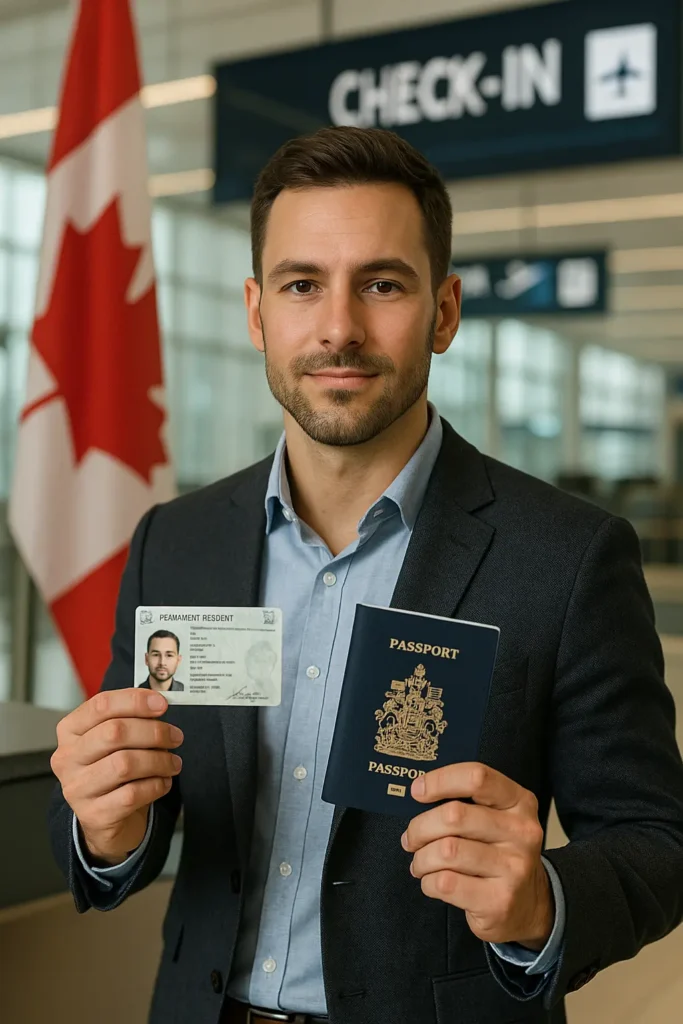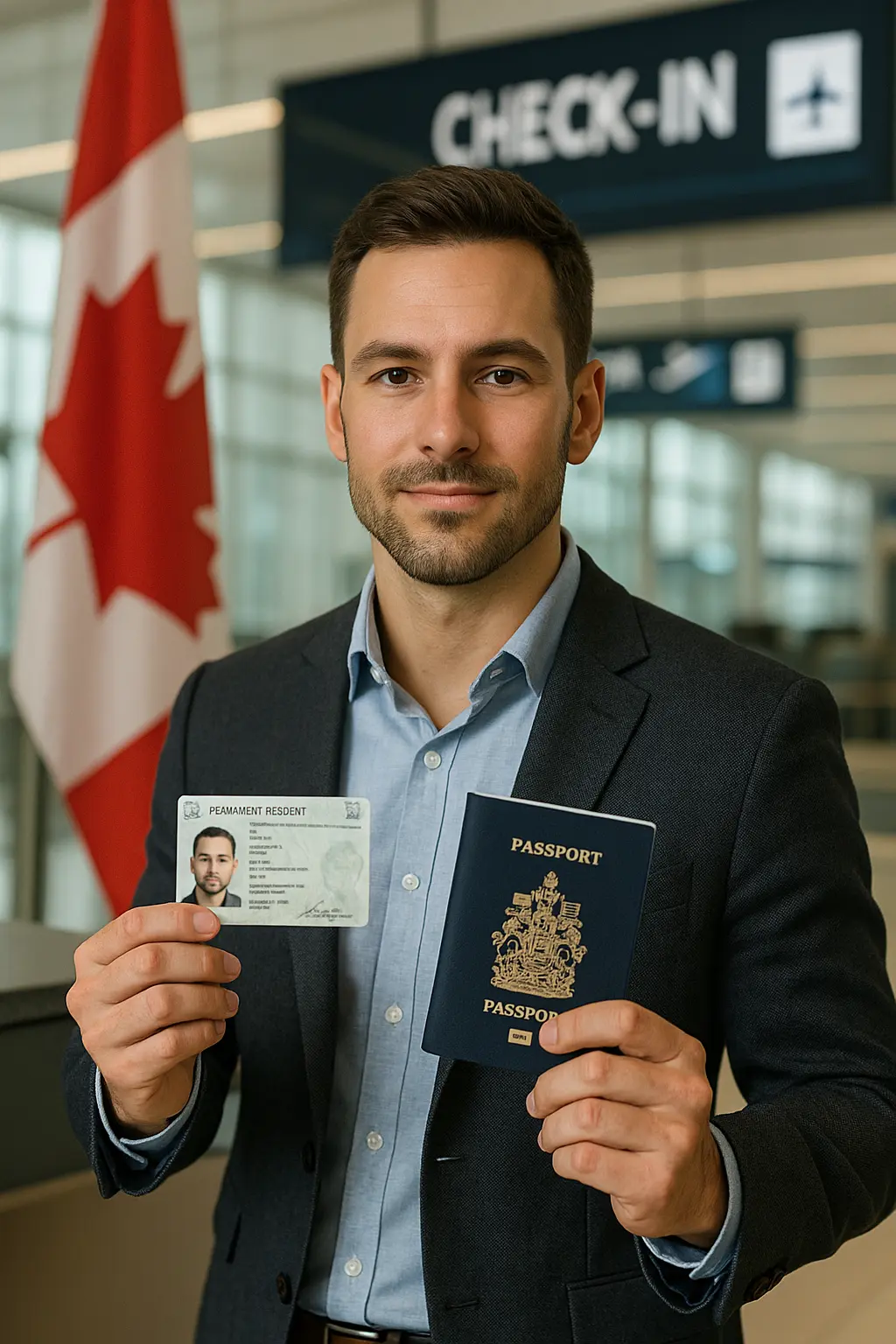Imagine this: your boarding pass is printed, your luggage is checked, and you’re mentally already in Canada. But at the gate, a gate agent shakes their head—your PR card expired. Suddenly, your trip turns into a scramble to prove your status and get back home.
For many permanent residents (PRs), permanent resident travel to Canada isn’t just a routine journey. It’s a delicate dance with documentation, border security, and immigration compliance. Whether it’s your first time re-entering or you’re a frequent traveler, there’s one truth: the smallest oversight can cost you time, money, or even entry.
That’s why this guide was made for you. You’ll learn how to travel smart, stay compliant, and avoid the unexpected traps that could delay—or completely deny—your return to Canada.

Table of Contents
Understanding Your Status: What Being a Canadian Permanent Resident Really Means
What Is a Canadian Permanent Resident?
You’ve earned your Canadian PR status, but what does that truly mean?
A permanent resident is someone who has been granted the right to live and work in Canada permanently—but who is not yet a Canadian citizen. You have access to most of the same benefits as citizens, including healthcare and education, but there are rules you must follow to maintain your status.
You’re expected to:
- Carry valid PR identification when traveling
- Renew your PR card before it expires
- Spend enough time in Canada to meet the 730-day residency rule
- Avoid any serious legal violations that could affect your status
The Documents You Need When You Travel
As a PR, permanent resident travel to Canada requires proper documents. Traveling without them can stop you in your tracks. Here’s what you need before boarding a plane, bus, train, or ship to Canada:
- Valid PR card: Your passport isn’t enough. Your PR card is proof of your status.
- Passport: You’ll still need this from your country of origin.
- PRTD: If your PR card has expired while abroad, you must apply for a Permanent Resident Travel Document.
- Optional but helpful: Tax filings, property deeds, or employment letters that prove your ties to Canada.
Travel Requirements for Permanent Residents Re-Entering Canada
Your Pre-Boarding Entry Checklist
Make sure you have all this in place before you try to return to Canada:
| Required Document | Purpose | Notes |
|---|---|---|
| PR card | Proof of PR status | Must be valid on travel date |
| Passport | Official travel ID | Must match your PR records |
| PRTD (if needed) | Temporary substitute for PR card | Only from outside Canada |
| Proof of residence | Supportive evidence | Useful if status is questioned |
Common Reasons for Delays and Denials
Don’t assume you’ll be allowed in just because you’re a PR. These are the most common snags people run into:
- Expired PR card: Airlines won’t take chances.
- Not meeting the 730-day rule: Canada Immigration can challenge your status.
- Missing travel documents: Even one missing piece can delay your return.
- Security or customs flags: Past immigration violations or missing documentation can raise red flags.
How to Avoid Denials: Smart Planning Before, During, and After Travel
Before You Leave Canada
Being proactive makes all the difference. Here’s what to do before you even book your ticket:
- Check your PR card’s expiration date. Renew early—processing times vary.
- Leave a copy of your PR card and passport with a trusted friend in Canada.
- Carry more than just your PR card. Bank statements, phone bills, and CRA tax returns help prove you live in Canada.
- Consider travel insurance in case you’re stuck abroad longer than expected.
While Abroad: Stay Connected to Canada
Your ties to Canada matter—even when you’re away. Immigration officers may ask for proof that you’ve maintained those connections.
Keep these updated:
- Tax filings: File taxes as a Canadian PR, even if living abroad temporarily.
- Bank accounts and bills: Avoid canceling everything—it proves you still “live” in Canada.
- Communication records: Document when and why you traveled.
Save receipts, boarding passes, and email confirmations. They help prove how long you’ve been outside Canada.
If Your PR Card Expires While You’re Away
It happens more often than you’d think. If your PR card expires while you’re abroad, here’s what you need to do:
- Apply for a PRTD at the nearest Canadian visa office.
- Provide evidence of:
- Your PR status (e.g., expired card, landing documents)
- Why you’re returning (employment, family, medical)
- That you meet the 730-day rule or have compelling reasons
- Wait for approval before booking your return flight.
Processing times vary by country, but they can range from 5 to 30 days. Plan accordingly.
Insider Tips From Immigration Experts
Real-World Examples
Case 1: Julia from Germany
Julia forgot to check her PR card before flying to Europe. At check-in for her return to Toronto, the airline refused to board her. She had to reschedule her trip and apply for a PRTD from Berlin—adding three weeks and €400 in costs.
Case 2: Harun from Kenya
Harun stayed abroad for family matters and didn’t meet the 730-day residency rule. Upon arrival, he was given a “Departure Order.” He appealed and provided medical records to support his case—and won.
Case 3: Lena from Brazil
Lena’s meticulous planning paid off. She carried a valid PR card, travel history, utility bills, and a recent Notice of Assessment from the CRA. At customs, she was waved through in minutes.
Immigration Officer Insights
Immigration officers often look for:
- Consistency in your explanation
- Clear, traceable documents
- Respectful behavior during questioning
“You’d be amazed how many people try to re-enter with expired cards and no explanation. Preparation is the best sign of intent,” says a retired CBSA agent.
Final Checklist Before Traveling to Canada
Must-Haves for Permanent Resident Travel to Canada
- Valid PR card (or PRTD if expired)
- Passport (same one used when you landed)
- Proof of ties to Canada (taxes, leases, employment, etc.)
- Copies of your travel itinerary
- Emergency contacts in Canada
Keep both digital and physical copies of every key document. Airlines and border agents may ask for originals, scans, or both.
Conclusion:
Traveling as a Canadian PR doesn’t have to be complicated—but it does require preparation. A simple expired card or missing form can delay you for days or even weeks. And while border agents might be understanding, airlines often aren’t.
By following the tips in this article, you’re now better equipped to handle every aspect of permanent resident travel to Canada without stress.
Your journey back to Canada should be joyful, not difficult.
FAQ : Permanent Resident Travel to Canada
Can I travel to Canada with an expired PR card?
Only if you obtain a PRTD first. Airlines will not let you board without proof of PR status. Canadian border agents can’t override airline rules.
How long can I stay outside Canada as a PR?
You must be physically present in Canada for at least 730 days within any 5-year period to maintain your status.
Do I need an ETA or visitor visa as a PR?
No. If you’re a permanent resident, you don’t need an Electronic Travel Authorization (ETA) or visa. You just need your PR card or PRTD.
What if I’m denied boarding by the airline?
You’ll need to contact a Canadian visa office abroad and apply for a PRTD. This is your only option for re-entry if your PR card has expired.
Will I lose PR status if I’m outside Canada too long?
If you don’t meet the 730-day rule, you may be deemed to have abandoned your status. However, you may appeal if you have valid humanitarian or compassionate reasons.








Leave a Reply